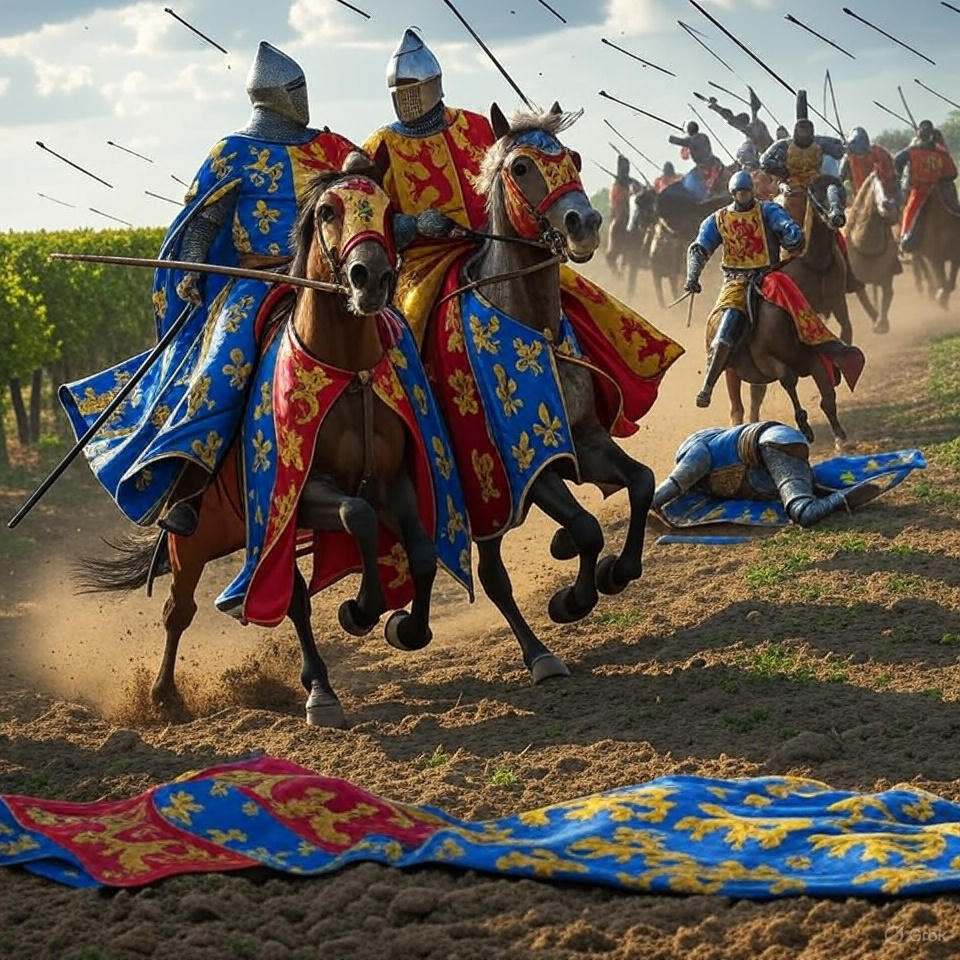Imagine a misty morning in medieval France, where a small band of exhausted English and Gascon soldiers, outnumbered more than two to one, stand their ground on a sloping hillside. The air is thick with tension as the mighty French army, led by their own king, advances with the clatter of armor and the thunder of hooves. This wasn’t just any skirmish—it was the Battle of Poitiers on September 19, 1356, a clash that captured a king, reshaped the map of Europe, and echoed through the annals of history as a testament to strategy, courage, and sheer audacity. In this blog, we’ll dive deep into the riveting details of this pivotal event from the Hundred Years’ War, exploring its background, the dramatic buildup, the brutal fighting, and its far-reaching consequences. Then, we’ll bridge the centuries to see how the outcomes of that fateful day can inspire and transform your everyday life today. Get ready for a journey that’s packed with facts, fun anecdotes, and a motivational kick to boot—because history isn’t just about the past; it’s a blueprint for winning your own battles.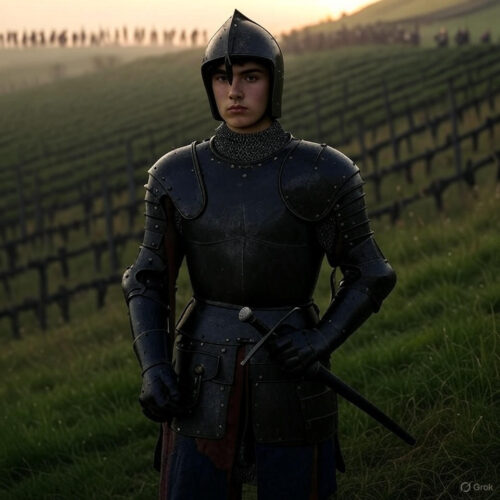
### The Historical Tapestry: Setting the Stage for Poitiers
To truly appreciate the Battle of Poitiers, we must first unravel the complex web of the Hundred Years’ War, a conflict that spanned from 1337 to 1453 and pitted England against France in a struggle for territory, crowns, and dominance. The war’s roots traced back to the intricate feudal ties between the two nations. Edward III of England, who ascended the throne in 1327, held significant lands in France as the Duke of Aquitaine (also known as Gascony), a remnant of the Angevin Empire built by his ancestors like Henry II. These holdings were vassal to the French king, creating constant friction. When Philip VI of France confiscated Gascony in 1337, citing Edward’s failure to pay homage properly, Edward retaliated by claiming the French throne himself, based on his descent from Philip IV of France through his mother, Isabella.
The early years of the war saw English triumphs, fueled by innovative tactics and the devastating power of the longbow. The naval Battle of Sluys in 1340 decimated the French fleet, while the land Battle of Crécy in 1346 showcased the effectiveness of dismounted knights supported by archers against traditional French chivalry. Crécy was a humiliation for France, with thousands of nobles slain, including King Philip VI’s brother. The English followed up by capturing the strategic port of Calais in 1347 after a grueling siege. However, the war ground to a halt in the late 1340s due to the Black Death, the bubonic plague that ravaged Europe from 1347 to 1351. This pandemic killed an estimated 30-50% of Europe’s population, including over 40% in southern England, crippling economies and armies alike. Armies were decimated not just by disease but by the labor shortages that followed, making large-scale campaigns impractical.
By the mid-1350s, both sides were itching to resume hostilities. A truce signed in 1347 had expired, and negotiations for a permanent peace faltered. Edward III, a shrewd and ambitious monarch, devised a multi-pronged strategy to pressure France. In 1355, he sent his eldest son, Edward, Prince of Wales—later dubbed the Black Prince for his dark armor or perhaps his fierce reputation—to lead operations from Bordeaux, the capital of English Gascony. The Black Prince, born in 1330, was already a seasoned warrior at 25, having fought at Crécy where he earned his spurs. His mission was to conduct a “chevauchée,” a scorched-earth raid designed to devastate French lands, undermine the economy, and force concessions without sieging major cities.
The 1355 chevauchée was a masterclass in medieval warfare’s economic dimension. The Black Prince landed in Bordeaux on September 20 with about 2,200 English troops, bolstered by local Gascon lords to reach 5,000-6,000 men. They marched eastward to Narbonne near the Mediterranean, burning crops, vineyards, and towns, then looped back to Bordeaux. This raid destroyed over 500 settlements, causing millions in damage—equivalent to billions today—and highlighted Gascony’s value, as Bordeaux’s wine trade funded much of England’s war effort. Historian Clifford Rogers emphasized the “economic attrition” of such raids, noting they weakened France’s tax base and morale. The French, under the new King John II (who succeeded Philip VI in 1350), were hamstrung by internal divisions. John, nicknamed “the Good” for his chivalry but criticized for poor governance, faced rebellions from nobles like Charles II of Navarre, who allied with England.
As 1356 dawned, the stage was set for escalation. France’s administration was in disarray, with Sumption describing it as falling apart in “jealous acrimony and recrimination.” John arrested Navarre, prompting Norman nobles to seek English aid. Edward III dispatched Henry, Duke of Lancaster, to Normandy in June 1356, where he raided unchecked. John besieged Breteuil but allowed the garrison to depart freely around August 20, freeing his army to march south against the Black Prince.
### The Road to Confrontation: Prelude to the Battle
The Black Prince’s 1356 campaign began on August 4 from Bergerac, with a force of approximately 6,000 fighting men—3,000 men-at-arms, 2,000 longbowmen, and 1,000 Gascon infantry—plus 4,000 non-combatants. All were mounted for mobility, but the English fought dismounted, a tactic proven at Crécy. The army split into three columns, 40 miles apart, to maximize destruction across Berry, Auvergne, and Limousin. They sacked towns like Vierzon and Romorantin, where the Black Prince personally led an assault after his standard-bearer was killed.
By early September, the Anglo-Gascons reached the Loire near Tours, hoping to link with Lancaster. However, French forces held the bridges, and high waters prevented crossing. Lancaster, pursued by John, retreated to Brittany without uniting. The Black Prince, laden with loot, turned south to evade John, who had assembled a massive army of 14,000-16,000, including 10,000-12,000 men-at-arms, 2,000 crossbowmen, and 2,000 infantry. John’s force included elite knights and a contingent of Scots under Sir William Douglas.
The pursuit was a game of cat and mouse. John crossed the Loire at Blois, marching hard to intercept the slower English column. By September 17, scouts reported contact near Poitiers. The Black Prince, low on supplies and with tired troops, sought battle on favorable terms, knowing John’s eagerness from Normandy. On September 18, the armies camped close, with Cardinal Talleyrand de Périgord mediating. The Black Prince offered to return booty and agree to a seven-year truce, but John demanded surrender, which was rejected. As negotiations failed, both sides prepared for combat.
### The Armies Arrayed: Opposing Forces and Tactics
The Anglo-Gascon army was a cohesive, veteran force. Men-at-arms wore plate armor, bascinets with visors, and carried lances used as pikes, swords, and axes. Longbowmen, the English secret weapon, could loose 10 arrows per minute up to 330 yards, with bodkin tips piercing armor at 250 yards. Each carried 24 arrows, resupplied during lulls. The army divided into three “battles”: the vanguard under the Earl of Warwick (1,000 men-at-arms, 1,000 archers), the center under the Earl of Salisbury (similar composition), and the rear under the Black Prince (1,000 men-at-arms, 1,000 Gascons), with deputies like John Chandos and the Captal de Buch.
The French, vastly larger, were less disciplined. Their men-at-arms matched English equipment, but crossbowmen were slower than longbows. Influenced by Crécy, John ordered most to dismount, except two mounted groups of 300-500 knights. The army formed four battles: the first mounted under Marshals Clermont and Audrehem, the second dismounted under Dauphin Charles, the third under the Duc d’Orléans, and the fourth under John himself.
The battlefield was a sloping vineyard near Nouaillé-Maupertuis, south of Poitiers. The English occupied a hilltop, protected by a marsh on the left, wagons on the right, and a hawthorn hedge with a narrow gap in front. Archers lined the hedge, creating a kill zone.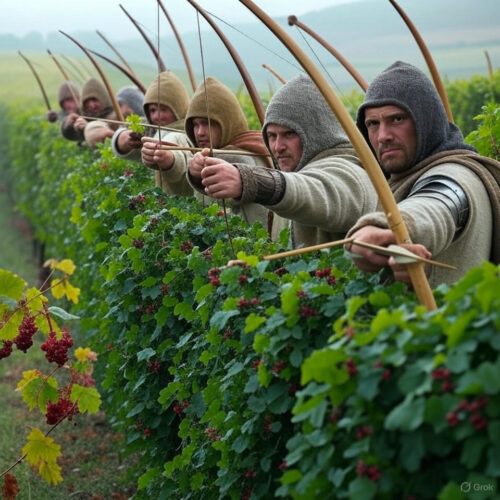
### The Clash of Steel: The Course of the Battle
Dawn on September 19 broke with the English attempting a withdrawal, but French scouts spotted them, forcing a return to positions. The battle commenced around 8 a.m. with the French mounted charge—a “forlorn hope” of 300 German mercenaries and knights under Clermont and Audrehem. They aimed for the hedge gap but were met by a hail of arrows. Horses fell, knights were unhorsed, and chaos ensued. English men-at-arms surged forward, capturing or killing many, including Clermont. Audrehem was captured after a duel with Sir James Audley, who fought heroically despite wounds.
The second French battle, led by the Dauphin, advanced dismounted up the slope. Exhausted from the march in heavy armor, they faced relentless archery. Reaching the hedge, fierce hand-to-hand combat erupted. The French nearly broke through, but English reserves stabilized the line. After hours of grueling fighting, the Dauphin’s force retreated, colliding with the advancing third battle under d’Orléans, causing panic. The third battle fled without fully engaging, leaving John with only his battle.
Seeing the French wavering, the Black Prince seized the moment. Around noon, with arrows low, he ordered a general advance. Archers drew knives and joined the fray. Simultaneously, the Captal de Buch led a small mounted reserve around the flank, striking the French rear with cries of “St. George for Guienne!” The French, surrounded, fought desperately. King John, axe in hand, battled alongside his son Philip (later “the Bold”), who warned “Father, ware right! Ware left!” But they were overwhelmed. John surrendered to Denis de Morbecque, a Gascon knight, after slaying several foes.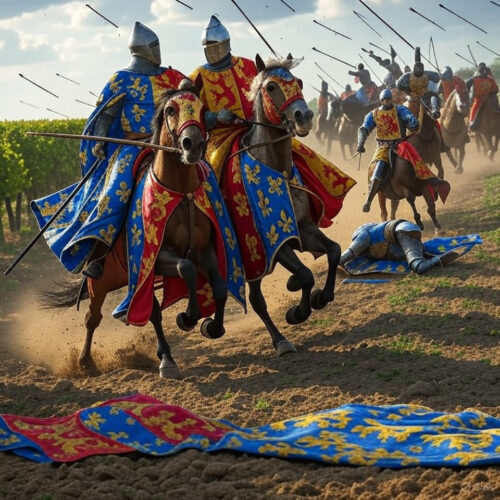
The battle lasted until early afternoon, with English pursuing fugitives to Poitiers’ gates, which remained closed, leading to more slaughter. Fun fact: one English knight, Sir Reginald Cobham, reportedly killed 14 French knights single-handedly, showcasing the era’s chivalric bravado.
### Repercussions and Legacy: Aftermath and Historical Significance
Casualties were lopsided: English losses around 200-1,000 dead, French 2,500 dead and 2,600 captured, including 100 knights. The capture of King John was a coup; he was treated honorably by the Black Prince, dining with him that night. The prince remarked, “It was not your fault, but now you are the bravest of kings.” John was ransomed for 3 million crowns (half France’s annual revenue), but died in 1364 before full payment.
The victory led to the Treaty of Brétigny in 1360, where England gained Aquitaine, Poitou, and Calais, controlling nearly a third of France. Edward III renounced his claim to the French throne. However, the treaty unraveled, and war resumed in 1369. Poitiers weakened French monarchy, sparking the Jacquerie peasant revolt in 1358 and empowering the Estates General. It highlighted the longbow’s supremacy and dismounted tactics, influencing warfare until gunpowder’s rise.
Economically, the ransom enriched England, funding castles and arts. Culturally, it inspired chronicles like Froissart’s, romanticizing chivalry. The Black Prince became a legend, though his later illness and death in 1376 left England vulnerable. Poitiers exemplified how superior tactics could overcome numbers, a lesson echoed in later battles like Agincourt in 1415.
The battle’s site, now peaceful fields, hosts reenactments, reminding us of medieval warfare’s brutality—knights in 60-pound armor fighting for hours, the ground slick with blood, the air filled with screams and arrow whistles. It’s a vivid snapshot of an era where honor, loyalty, and strategy defined destinies.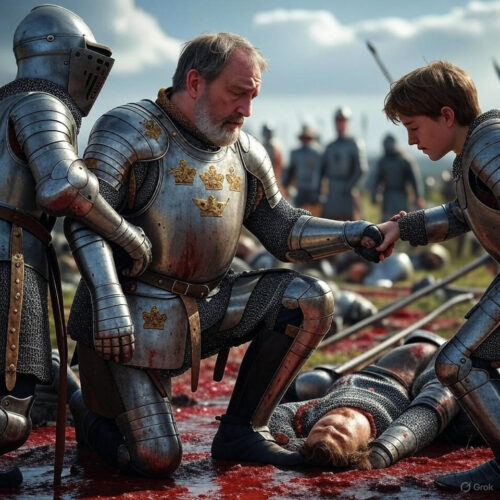
### From Medieval Fields to Modern Triumphs: Applying Poitiers to Your Life
The Battle of Poitiers wasn’t just a victory of arms; it was a triumph of mindset. Outnumbered and cornered, the Black Prince turned defense into offense through clever positioning, resource management, and timely boldness. Today, in a world of challenges like career setbacks, personal goals, or health hurdles, these principles can empower you to defy odds and capture your own “kings”—those elusive successes. Here’s how this historical gem benefits you, with specific applications to fuel your motivation.
– **Embrace Strategic Positioning for Daily Wins**: Just as the English used the hawthorn hedge and slope to neutralize French numbers, position yourself advantageously in life. For instance, if pursuing a promotion, network with key influencers months in advance rather than scrambling last-minute—build your “hedge” of relationships to channel opportunities your way.
– **Leverage Resources Wisely Amid Scarcity**: English archers reused arrows from the fallen, turning limitation into strength. Apply this by auditing your time and skills; if budgeting for a dream vacation, track expenses meticulously and repurpose savings from cutbacks, like brewing coffee at home to fund flights.
– **Turn Defense into Offense at the Right Moment**: The Black Prince’s counterattack flipped the script. In fitness, if plateaued on weight loss, defend your routine initially (consistent workouts), then offend with a bold change like high-intensity intervals to break through.
– **Foster Team Unity in Adversity**: Gascons and English fought as one under shared leadership. In family or work teams, build cohesion by assigning roles based on strengths—e.g., delegate meal prep to the organized spouse during busy weeks to maintain household harmony.
– **Celebrate Captures with Grace**: The prince honored captured John, preserving dignity. After achieving a goal, like landing a job, thank mentors graciously and mentor others, creating a cycle of positive karma.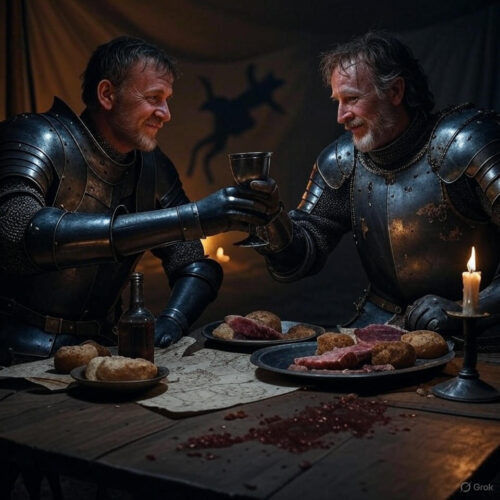
To integrate these into your life, follow this actionable plan:
- **Assess Your Battlefield (Week 1)**: Identify a personal challenge, like improving health. Map “terrain”—strengths (e.g., discipline), weaknesses (e.g., time constraints), and “enemies” (e.g., junk food temptations).
- **Build Your Defenses (Weeks 2-3)**: Set up barriers, such as meal prepping Sundays to hedge against weekday slips. Gather “arrows”—resources like apps for tracking calories.
- **Train Your Forces (Weeks 4-6)**: Practice daily habits, like 30-minute walks, building endurance like the dismounted knights.
- **Launch the Counterattack (Week 7+)**: When ready, escalate—join a gym or run a 5K. Monitor progress and adjust, reusing what works.
- **Secure and Reflect (Ongoing)**: Celebrate milestones with grace, like a healthy treat, and review lessons to prepare for future “battles.”
By channeling Poitiers’ spirit, you’ll not only overcome obstacles but thrive, turning history’s echoes into your personal symphony of success. Remember, the Black Prince was 26—age is no barrier to legendary feats!

